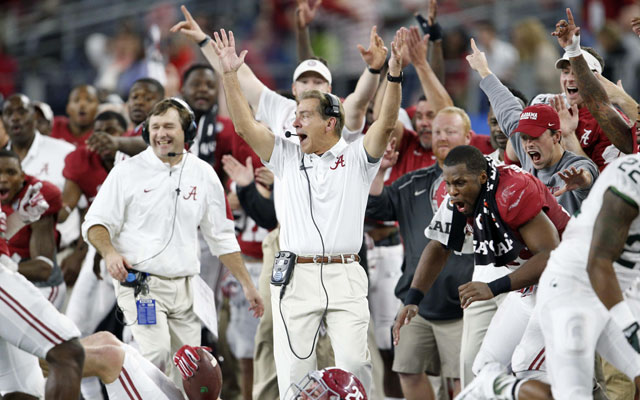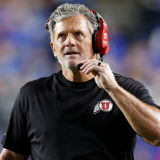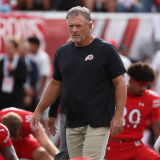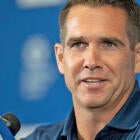Alabama, Clemson roll into title game with $3 million football support staffs
The players and coaches for the College Football Playoff National Championship competitors get all the credit, but both the Crimson Tide and Tigers have multimillion-dollar support staffs off the field.

PHOENIX -- Alabama strength and conditioning coach Scott Cochran began his career 18 years ago as an unpaid volunteer at University Laboratory High School in Baton Rouge, Louisiana. He could never have imagined then he would be a strength and conditioning coach making more money than 18 major college football head coaches.
Cochran’s compensation in 2015 totaled $517,045, according to university records, and that’s before his salary will reportedly jump to more than $600,000 for not taking a job at Georgia. College football has reached the point where the Alabama strength and conditioning coach got paid nearly as much as Alabama’s outgoing president ($565,000).
“Unreal,” Cochran said of his salary. “Not worthy, not worthy at all. But it doesn’t change. The job is still the same. It shows the value has increased because people see how important it is, which is great. It’s awesome for the field. With that comes great responsibility.”
Shortly after arriving at Alabama in 2007, Nick Saban created a new cottage industry: football support staff. These people can help football programs in many different ways, depending on certain NCAA restrictions, such as recruiting, analyzing film, mentoring players, managing video, handling travel operations and building players’ strength and speed.
The 2016 College Football Playoff National Championship on Monday between Alabama and Clemson is a byproduct of the fierce competition that goes on behind the scenes, not to mention the enormous money spent on these employees. Both schools used football analysts -- people with coaching backgrounds who by NCAA rule can’t coach on the field -- to evaluate both potential championship game opponents even before the semifinal games were played.
“We finished up our last championship opponent the day we arrived in Miami (for the Orange Bowl),” said Andrew Warwick, whose title at Clemson is defensive player development. “We were probably behind schedule a little bit, to be honest with you. It would be tough in the playoff without these many people -- the quick turnaround, the magnitude of the game, the amount of information that you have to have, how complex offenses and defenses are now. You wouldn’t sleep as much. As it is, we don’t sleep a lot anyway.”
In its 2013-14 NCAA financial report, Alabama reported spending $2.7 million on football support staff. (That's the most recent year of NCAA financial data currently available.) The school spent $837,000 on a much smaller support staff in 2005-06, the final full year under former coach Mike Shula. By Saban’s first full year in 2007-08, salaries for the support staff soared to $1.9 million.

Clemson reported spending $2.5 million on football support staff in 2013-14, up from $480,000 about a decade ago. Dabo Swinney significantly increased the number of additional staffers and the pay for those employees since he became the full-time head coach in 2009.
“We used to have one GA,” Swinney said. “Now the GAs have GAs. They have their own staff. I tell these guys sometimes, like man, y’all have no clue.”
More money for these additional football employees has come during a period when the NCAA and the five major conferences have faced litigation about whether college athletes should be allowed to get paid. The NCAA has changed its rules to permit athletes to receive cost-of-attendance stipends above their scholarship value, extra meals and snacks, and promises not to cut their scholarships for athletic purposes.
Still, the more money college football makes, the more money it needs to spend on something. Welcome to the playoff era, where specialization rules and some schools will pay for any edge they can get.
College teams become mini-NFL organizations
Other than on-field coaches, strength and conditioning coaches such as Cochran and Clemson’s Joey Batson have received some of the biggest pay increases in recent years. Records from the South Carolina Department of Administration show that Batson went from $114,000 in 2009 to $245,000 in 2015, a 94-percent increase when factoring inflation.
Strength coaches are viewed as vital support staff members because they have access to players during times other coaches aren’t allowed under NCAA rules. Strength coaches build bodies and generate work ethic and attitudes during the offseason that coaches and players say helps them in the fall.
“Basically, I’m Coach Swinney’s eyes and ears and mouth to the team,” Batson said. “I think you kind of have the pulse of the team. My job is to shape this team and this program into his personality and what he wants for the total program.”
NCAA rules limit football teams to five strength and conditioning coaches, and Alabama and Clemson each carry the maximum. Several years ago, Batson used to oversee additional teams at Clemson until it evolved so he could focus only on football.
“I kind of saw it coming,” Batson said about a strength and conditioning coach making half a million dollars. “I think with the demands of the job, the responsibility that goes with it, it doesn’t surprise me. With that price tag carries a lot of responsibility 24/7. You want to put so much into it, you should get compensated for it.”
It’s not just strength and conditioning coaches who are getting more money. College football programs are now filled with employees making six figures even though under NCAA rules they can't coach on the field. Their value is behind the scenes.
| Partial List of Alabama Support Staff | ||
| Name | Job Title | 2015 Pay |
| Scott Cochran | Strength and Conditioning Coach | $517,045 |
| Kerry Stevenson | Director of Player Personnel | $181,309 |
| Jody Wright | Director of Player Personnel | Not available |
| Justin Dickens | Director of Football Operations | $149,750 |
| Jeff Allen | Head Athletic Trainer | $147,803 |
| Cedric Burns | Athletic Relations Coordinator | $130,738 |
| Freddie Roach | Director of Player Development | $129,477 |
| Glenn Schumann | Player Development/Player Personnel | $116,333 |
| Amy Bragg | Director of Performance/Nutrition | $113,182 |
| Ashleigh Kimble | Assistant Director of Player Personnel | $68,370 |
| Asha Sovell | Recruiting Operations Coordinator | $55,289 |
| Ellis Ponder | Associate Director of Football Operations | $23,462* |
| Eight football analysts (Keary Colbert, Dean Altobelli, Brandon Farrell, Garrett Cox, William Vlachos, Wes Neighbors, Charlie Weis Jr., Eric Kiesau) earned between $47,409-$23,462. * Did not work at Alabama for all of 2015. |
||
| Source: University of Alabama Division of Financial Affairs | ||
Video graduate assistants, on-field graduate assistants and football analysts crunch film. They diagram and organize playbooks, make cutups, help put together scouting reports and make sure playbooks are available in different formats depending on how a player learns best.
“It allows coaches to focus on coaching,” Alabama defensive coordinator Kirby Smart said. “It allows more input. It also allows you to see an offense from years past, look at (what they did) three years ago and what they did in a situation. It just gives you more manpower and gets you more ready."
If this sounds like a mini-NFL organization, well, “it really does,” acknowledged Clemson director of recruiting Brad Scott, who is charged with helping freshmen football players off the field. “I think you’re seeing some patterns from the NFL. They might call their guys 'quality control,' and our guys are 'player development' and analysts for the coaches.”
And the money within this cottage industry is growing.
For instance, Alabama director of player personnel Kerry Stevenson made more in 2015 ($181,309) than 45 percent of the FBS assistant coaches listed in the USA Today coaching salary database. Mike Dooley, Clemson’s director of high school relations and player personnel, wasn’t far behind Stevenson at $150,000.
Stevenson’s salary was higher than on-field assistants at schools such as Oklahoma State, Utah, North Carolina, Colorado, Oregon State, Illinois, Virginia, Maryland, Indiana, Purdue and California. Four assistants at Kansas made less than Stevenson.
Woody McCorvey, Clemson associate athletic director for football administration, made $245,000 in 2015, a 77-percent increase when factoring in inflation since he was hired in 2009. McCorvey’s salary today mirrors what Clemson on-field assistant coaches made four years ago.
McCorvey said he views his role as general manager of Clemson’s football team. When McCorvey took the job in 2009, he talked to three NFL general managers at the time -- Ozzie Newsome of the Baltimore Ravens, Buddy Nix of the Buffalo Bills and Kevin Colbert of the Pittsburgh Steelers -- to develop a GM model for college football.
McCorvey supervises the football budget and works with other staffers to oversee players’ academic progress. Swinney has referred to McCorvey, a former Clemson and Alabama assistant coach, as “my national security advisor.”
| Partial List of Clemson Support Staff | ||
| Name | Job Title | Salary |
| Woody McCorvey | Associate AD/Football Administration | $245,000 |
| Joey Batson | Director of Strength and Conditioning | $245,000 |
| Brad Scott | Assistant AD/Director of Recruiting | $208,080 |
| Thad Turnipseed | Director of Recruiting and External Affairs | $160,000 |
| Mike Dooley | Director of High School Relations/Player Personnel | $150,000 |
| Jeff Davis | Assistant AD/Football Players Relations | $135,802 |
| Andrew Warwick | Defensive Player Development | $99,282 |
| Danny Poole | Director of Sports Medicine | $96,000 |
| Todd Green | Director of Football Coaching Technology | $84,000 |
| Daniel Bassett | Director of Football Programs | $78,000 |
| Lemanski Hall | Defensive Analyst/Research Development | $67,000 |
| Abe Reed | Director of Equipment | $63,000 |
| Brandon McCombs | Special Teams Analyst/Research Development | $53,010 |
| Lisa Chan | Sports Nutritionist | $51,500 |
| Source: South Carolina Department of Administration (database only includes state salaries above $50,000) | ||
McCorvey said he and assistant athletic directors Jeff Davis and Scott constantly communicate with the academic staff via email. They are a filter for what Swinney and other assistants do or don’t need to handle.
“It helps free up coaches so you don’t bring them in academic meetings all the time,” McCorvey said. “Those meetings can be really time-consuming.”
Scott, a former South Carolina head coach and Clemson offensive coordinator, describes himself as the “freshmen player development guy” who insulates Swinney from minor issues that parents or players might think are huge. By that, he means once a player enrolls to Clemson, Scott is their “coach” off the field for their first year and he handles housing, dining, study hall and tutorial programs, just to name a few areas.
“It’s to make sure they don’t fall through the cracks,” Scott said. “Freshmen get here and there’s so much expectations. They’ve got a little entitlement issue, too. So Coach felt like, especially as your talent pool gets better, those guys start at the back of the line and it’s tough to stay on top of them. My job is to make sure someone is watching after freshmen.”
Scott is also in charge of helping committed recruits jump through NCAA hoops to become academically eligible, a duty that an on-field assistant used to handle as recruiting coordinator. When a Clemson coach believes a player is good enough for a scholarship offer, Swinney turns to Scott to develop an academic profile on where the player stands to qualify. Scott said he becomes the person who realizes whether a recruit needs to retake a class sooner rather than later in his high school career to become eligible.
“It wasn’t that long ago when I was a head coach (1994-98) that you did a lot of this stuff, or it was on your desk and you were assigning coaches,” Scott said. “Some coaches were better at it than others, and sometimes you'd be a little disappointed that the follow-through wasn’t there. Maybe my job is the follow-through. You don’t see many programs making it to this level that don’t have a tremendous support staff around their head coach.”
'It's too big to be fair'
Mack Brown tried to change the proliferation of coaching staffs a couple years ago while coaching Texas. Brown was president of the American Football Coaches Association and voiced the organization’s recommendation of adding a 10th on-field coach (for special teams) and capping the number of non-coaching positions.
“We wanted to curb some of the 38 to 50 members that are around now that you’re not even sure what they’re doing,” Brown said. “To me, it’s too big to be fair to everybody because all we would be doing is letting those that have money and those that will spend that money in football getting ahead of others.”
NCAA rules limit on-field football staff sizes to one head coach, nine assistants and four graduate assistants. There are certain restrictions on what non-coaching staff can do, such as those employees can only chart statistics and can’t coach. But there’s no limit on how many people a football program can employ behind the scenes.
“Believe it or not, the Southeastern Conference introduced a legislative proposal (that didn’t gain national support) to govern the size of football staffs,” SEC commissioner Greg Sankey said. “A little bit against the narrative, right? We continue to have conversations about the proliferation staff size. Where’s the end of proliferating staff size?”
Clemson athletic director Dan Radakovich estimated Swinney’s football staff at 32 people, including the 10 on-field assistants, and said most of the growth is due to additional communication for recruiting. The personality of the head coach is a factor about whether he has a large staff, Radakovich said. “You have to have a coach that can manage that many people, otherwise it doesn’t work,” he said.
Added Radakovich: “It’s a lot of people. It does (add up financially). Clemson’s never run an athletic deficit and we get no money from the state, no money from the university, no money from our students. So this is coming from donors, ticket sales and our relationship within the Atlantic Coast Conference.”
One position on Swinney’s staff is essentially to stay on top of building projects with all of this new money. Thad Turnispeed, who came from Alabama three years ago, is the Clemson football team’s director of recruiting and external affairs. He has been a project manager and owner of private construction companies.
Swinney said Turnispeed, who made $160,000 last year, is his “hands on guy” for Clemson’s $55 million football facility that’s getting built seven years after the team moved into new offices.
“It’s awesome for me because he understands all that language with the architects and the engineers, and they don't pull anything over his head,” Swinney said. “He’s a bull in a China shop in that whole process and is doing a good job.”
For analysts in major college football programs, it’s a catch-22 on whether to leave the field as a coach.
Warwick, the 31-year-old defensive player development at Clemson, came to the Tigers with defensive coordinator Brent Venables in 2012 after previously coaching defensive backs at a small Division III school and a community college. Warwick said he was making $5,000 a year at his first job. State records show he made $99,282 in 2015 at Clemson, though Warwick said "that's news to me, I wish" and makes much less than that amount.
“Financially, I had to make that decision (to go to Clemson),” Warwick said. “As far as career-wise, I don’t know. Giving up being on the field, it’s really tough. I came to Clemson because it’s the best thing for me professionally, learning linebacker play from Coach Venables. I want to be on the field.”
Some football analysts are young and just getting started in the business. Others have been established coaches and need a job, or they want to learn from elite coaches and get a major program on their resume.
"Regardless of where they need to start professionally, I think this is a great thing for our profession, to be abe to help develop coaches," Saban said, "and I think those guys now have created a role and a niche for themselves that's very important to every program because we all depend on them."
Two Alabama analysts recently got prominent on-field assistant coaching jobs. Eric Kiesau, a former Washington and Colorado offensive coordinator who also spent five years at Cal, went from Alabama analyst to Fresno State offensive coordinator.
Glenn Schumann, an Alabama defensive analyst, will follow Smart to Georgia to become an on-field assistant. Smart referred to Schumann as his “right-hand man” with the Crimson Tide defense and praised his work for prepping players for practices.
“He reminds me a lot of myself as a football junkie who’s always around the game,” Smart said.
For McCorvey, the Clemson football administrator who spent 26 years coaching Division I football, leaving the field to become “general manager” was extremely hard his first year.
“But once I got settled, I’m still involved in the industry I’ve been in ever since I graduated from college,” McCorvey said. “I’m still around the players. I’m still around the coaches. I tell people I’ve got the best job in America.”
It can also be a very lucrative job. In the multibillion-dollar industry of college sports, paying more for support staff is simply the price associated with trying to win football games.
“At the end of the day, a lot of people give a lot of money to our university and it helps us provide a lot of different things, so it’s quality control,” Warwick said. “We’re trying to put the best product out on the field and that’s the nature of the business.”
Follow and read more from Jon Solomon on Facebook and Twitter.
















